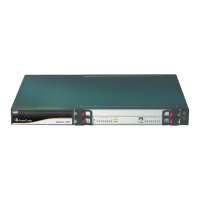User's Manual 680 Document #: LTRT-89730
Mediant 3000
44.1.3 Call Progress Tones File
The Call Progress Tones (CPT) Auxiliary file includes the definitions of the CPT (levels and
frequencies) that are detected / generated by the device.
You can use one of the supplied Auxiliary files (.dat file format) or create your own file. To
create your own file, it's recommended to modify the supplied usa_tone.ini file (in any
standard text editor) to suit your specific requirements and then convert the modified ini file
into binary format, using AudioCodes DConvert utility. For a description on converting a
CPT ini file into a binary dat file, refer to the DConvert Utility User's Guide.
Note: Only the dat file format can be loaded to the device.
You can create up to 32 different Call Progress Tones, each with frequency and format
attributes. The frequency attribute can be single or dual-frequency (in the range of 300 to
1980 Hz) or an Amplitude Modulated (AM). Up to 64 different frequencies are supported.
Only eight AM tones, in the range of 1 to 128 kHz, can be configured (the detection range
is limited to 1 to 50 kHz). Note that when a tone is composed of a single frequency, the
second frequency field must be set to zero.
The format attribute can be one of the following:
Continuous: A steady non-interrupted sound (e.g., a dial tone). Only the 'First Signal
On time' should be specified. All other on and off periods must be set to zero. In this
case, the parameter specifies the detection period. For example, if it equals 300, the
tone is detected after 3 seconds (300 x 10 msec). The minimum detection time is 100
msec.
Cadence: A repeating sequence of on and off sounds. Up to four different sets of
on/off periods can be specified.
Burst: A single sound followed by silence. Only the 'First Signal On time' and 'First
Signal Off time' should be specified. All other on and off periods must be set to zero.
The burst tone is detected after the off time is completed.
You can specify several tones of the same type. These additional tones are used only for
tone detection. Generation of a specific tone conforms to the first definition of the specific
tone. For example, you can define an additional dial tone by appending the second dial
tone's definition lines to the first tone definition in the ini file. The device reports dial tone
detection if either of the two tones is detected.
The Call Progress Tones section of the ini file comprises the following segments:
[NUMBER OF CALL PROGRESS TONES]: Contains the following key:
'Number of Call Progress Tones' defining the number of Call Progress Tones that are
defined in the file.
[CALL PROGRESS TONE #X]: containing the Xth tone definition, starting from 0 and
not exceeding the number of Call Progress Tones less 1 defined in the first section
(e.g., if 10 tones, then it is 0 to 9), using the following keys:
• Tone Type: Call Progress Tone types:
♦ [1] Dial Tone
♦ [2] Ringback Tone
♦ [3] Busy Tone
♦ [4] Congestion Tone
♦ [6] Warning Tone
♦ [7] Reorder Tone
♦ [17] Call Waiting Ringback Tone - heard by the calling party

